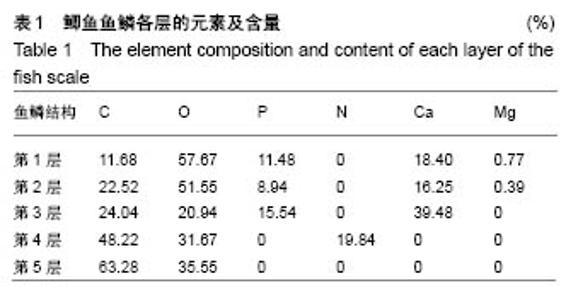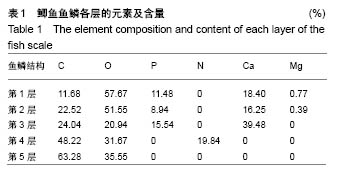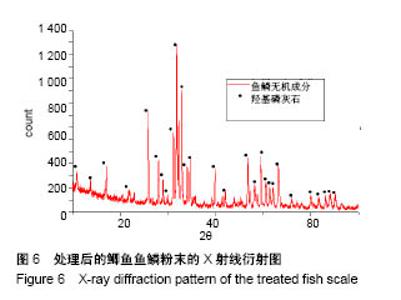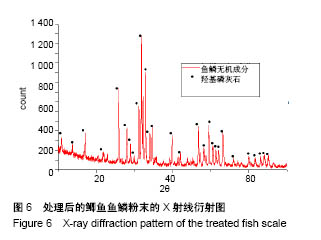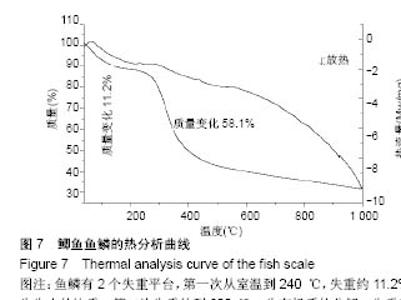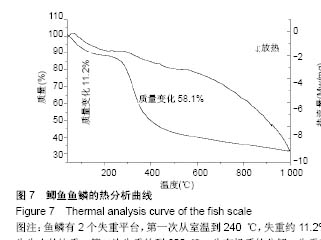Chinese Journal of Tissue Engineering Research ›› 2018, Vol. 22 ›› Issue (26): 4191-4195.doi: 10.3969/j.issn.2095-4344.0949
Previous Articles Next Articles
Characterization of the cross-structure and composition of crucian fish scales
Duan Ting-ting, Wang Ji-hui, Guo Yan, Xu Xing-ya, Wang De-gong, Zheng Wei, Huang Yu-song, Li Ning,Wang Ling, Xin Pei-xun
- Shangdong Institute of Nonmetal Materials, Jinan 250031, Shandong Province, China
-
Received:2018-04-05Online:2018-09-18Published:2018-09-18 -
Contact:Duan Ting-ting, Shangdong Institute of Nonmetal Materials, Jinan 250031, Shandong Province, China -
About author:Duan Ting-ting, Master, Shangdong Institute of Nonmetal Materials, Jinan 250031, Shandong Province, China -
Supported by:the Basic Research Funding for National Defense of China, No. JCKY2016208B012
CLC Number:
Cite this article
Duan Ting-ting, Wang Ji-hui, Guo Yan, Xu Xing-ya, Wang De-gong, Zheng Wei, Huang Yu-song, Li Ning,Wang Ling, Xin Pei-xun. Characterization of the cross-structure and composition of crucian fish scales[J]. Chinese Journal of Tissue Engineering Research, 2018, 22(26): 4191-4195.
share this article

2.1 鲫鱼鱼鳞的宏、介观结构 鱼鳞作为鱼体的“天然铠甲”对其内部组织起到屏障的作用,其表面形态对防护性能有很重要的作用[28-29]。光学显微镜下鱼鳞的外表面比较粗糙,见图1,鱼鳞整体分为明显的两部分,被上一层遮盖的区域为遮盖区,生长在真皮组织下,占鱼鳞整体的大部分面积,暴露区的颜色较深,一般呈现出黑色,是由于长期在水底,与外界环境作用导致;而颜色较深的鱼鳞与一些植物或是石块颜色相近,可躲避水底其他生物的攻击。鱼鳞表面有呈放射状的结构为鳞沟,见图1A,鳞沟之间的距离较均一且主要分在在暴露区,放射状的鳞沟顶点为中心区,即为鳞焦,遮盖区两侧有细密的生长线,暴露区没有生长线,存在环状的鳞嵴。鲫鱼鱼鳞厚度约为0.4 mm,光学显微镜下断面没有分层现象;鱼鳞整体呈现出不规则的六边形状态,以覆瓦形式排列于鱼体表面,形成微观的波纹状表面结构。鱼鳞的波纹状结构及覆盖在其表面黏液的共同作用,有利于推迟鱼在高速游动时体表层流边界层向紊流边界层转悷,降低运动阻力[30-31]。"

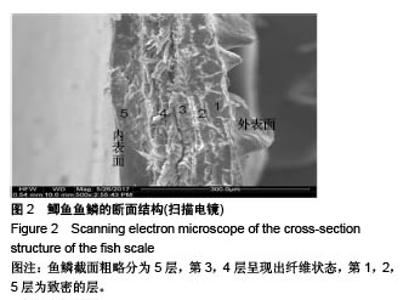
2.2 鲫鱼鱼鳞的微观结构 将鱼鳞用液氮冷冻使其结冰,进而脆断,但实验过程中发现,即使用液氮冷冻鱼鳞,其韧性依然很高,无法使其断裂,普通的材料如橡胶浸入液氮后会变成脆性材料,便于切割,但鱼鳞却不能,充分说明了鱼鳞性能的优越性。 将冷冻的鱼鳞片用剪刀剪开,扫描电镜观察截面,可粗略地分为5层,如图2;所标记顺序为外表面到内表面,外表面存在脊形凸起,是介观结构中暴露区存在的鳞嵴;从图中能明显的看出第3,4层呈现出纤维状态,而第1,2,5层都为较致密的层。扫描电镜观察鲫鱼鱼鳞断面结构可分为5层,再结合5层的元素及含量来看(表1),前3层的主要元素为碳、氧、磷和钙,属于无机成分,其中Ca/P在1.2-1.4之间;第4层主要有碳、氧和氮,且含有少量的其他元素,主要为有机成分;而最后一层仅含有碳和氧,是因为能谱聚焦受限实验结果不准确。一般羟基磷灰石中的Ca/P= 1.67,但从能谱分析结果来看,鱼鳞中的Ca/P比较低;但总的来说验证了鱼鳞外层为无机成分,而内层为有机物组成,是有机-无机组成的复合材料。此实验结果与文献报道相一致,但本研究中断面结构有明显的分层界面,这是其他文献中没有观察到的。但能谱分析结果只能说明鲫鱼鱼鳞是由有机-无机成分复合而成,但不能确定其具体的成分。"
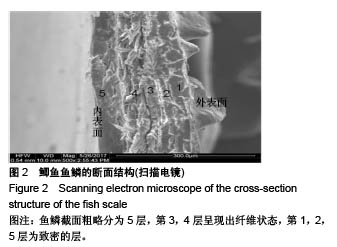

2.3 鲫鱼鱼鳞的红外光谱分析 将鱼鳞用去离子水清洗干净,放置数天至鱼鳞表面比较干燥,对鱼鳞的外表面和内表面分别进行红外光谱分析,确定鱼鳞所含有的官能团,并验证鱼鳞外表面和内表面分别为无机和有机成分,结果见图4,其中图4A为鱼鳞外表面光谱图,图4B为鱼鳞内表面光谱图。经过文献调研[32-33],鱼鳞的外表面在1 005 cm-1处强而宽的峰为PO43-的伸缩振动,869 cm-1和1 414cm-1为CO32-的面内弯曲振动峰,1 644 cm-1处为-OH的弯曲振动;内表面含有有机蛋白质的特征峰,1 629 cm-1处为酰胺Ⅰ带C=O的振动峰,1 543 cm-1为酰胺Ⅱ带N-H的弯曲振动峰,1 451 cm-1和1 379 cm-1为C-H键的弯曲振动引起的,1 337 cm-1为CO32-的反对称伸缩振动,1 238 cm-1为酰胺Ⅲ带,由于鱼鳞内表面含有有机胶原蛋白特有的酰胺带,因此,可确定鱼鳞中的有机成分为蛋白质,同时还含有磷酸根;通过实验分析表明,鱼鳞外表面主要为无机物,内表面主要为有机物,有机纤维板片中还含有少量的无机颗粒。"

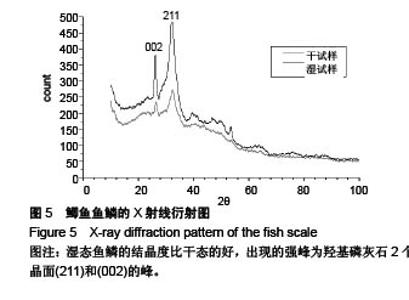
2.4 鲫鱼鱼鳞的射线衍射分析 选取新鲜鱼鳞和放置在空气中1个月的鱼鳞,选取较为平整的区域,进行X射线衍射分析,结果如图5,整体曲线图呈现有机物得峰形,两者的X射线衍射曲线出峰都很少,但就出峰范围来说比较一致,从两个X射线衍射曲线中可看出湿态下的结晶度比干态的好,出现的强峰为羟基磷灰石2个晶面(211)和(002)的峰[32]。 将鱼鳞水煮12 h后用马弗炉在900 ℃下煅烧并保温 1 h,得到白色鱼鳞粉末,将粉末充分研磨,进行X射线衍射实验,结果见图6,经过处理后的鱼鳞其衍射图中出峰很多,曲线经过拟合后,表明主要成分为羟基磷灰石,说明高温下鱼鳞中的有机成分已分解,剩余羟基磷灰石即为鱼鳞中的无机成分,从而验证了红外光谱中外层含有磷酸根的结果。"
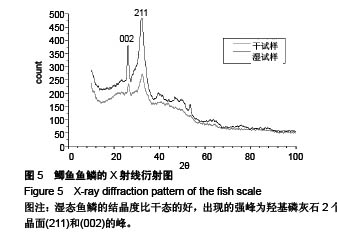
| [1] Kardong KV.Vertebrates : comparative anatomy, function, evolution. McGraw-Hill Higher Education, 2015.[2] Zarrin J,Rui LA,Barraca JP.Manycore simulation for peta-scale system design: Motivation, tools, challenges and prospects.Simulat Model Pract Theory.2017;72(8):168-201.[3] 聂小宝,潘洪民,程丽林,等.鲫鱼鱼鳞胶原蛋白提取工艺的研究[J].山东农业科学,2012,44(1):109-111.[4] Liu S,Zhao P,Zhang J,et al.Physicochemical and functional properties of silver carp (Hypophthalmichthys molitrix) myofibrillar protein glycated with konjac oligo-glucomannan.Food Hydrocoll.2017;67(6):216-223.[5] 陈日春,郑宝东.鲢鱼鱼鳞胶原蛋白抗氧化活性肽提纯及结构鉴定研究进展[J].食品安全质量检测学报,2017,8(4):1339-1345.[6] 杜嵇华,梁旭方,程佳齐,等.草鱼脂肪酸去饱和酶和延长酶基因cDNA全序列的克隆与分析[J].暨南大学学报(自然科学与医学版),2011,32(5):513-520.[7] Marino Cugno Garrano A,La Rosa G,Zhang D,et al.On the mechanical behavior of scales from Cyprinus carpio.J Mech Behav Biomed Mater. 2012;7:17-29.[8] Lin YS,Wei CT,Olevsky EA,et al.Mechanical properties and the laminate structure of Arapaima gigas scales.J Mech Behav Biomed Mater. 2011; 4(7):1145-1156. [9] Meyers MA,Lin YS,Olevsky EA,et al.Battle in the Amazon: Arapaima versus Piranha.Adv Eng Mater. 2012;14(5):B279-B288. [10] Vernerey FJ,Barthelat F.On the mechanics of fishscale structures.Int J Solids Struct.2010;47 (17):2268-2275. [11] Zimmermann EA,Gludovatz B,Schaible E,et al.Mechanical adaptability of the Bouligand-type structure in natural dermal armour.Nat Commun. 2013;4:2634. [12] 刘鹏,汪俊文,朱德举.草鱼鳞片的多级结构及力学性能[J].复合材料报, 2016, 33(3):657-665.[13] Yang W,Sherman VR,Gludovatz B,et al.Protective role of Arapaima gigas, fish scales:Structure and mechanical behavior.Acta Biomaterialia. 2014; 10(8):3599-3614.[14] Fang Z,Wang Y,Feng Q,et al.Hierarchical structure and cytocompatibility of fish scales from Carassius auratus.Mater Sci Eng C Mater Biol Appl. 2014;43:145-152.[15] Nicolas G,Gaill F,Zylberberg L.In situ localization of twofibrillar collagens in two compact connective tissues by immunoelectronmicroscopy after cryotechnical processing.Histochem Cytochem. 1997;45:119-128.[16] Oslon OP,Watabe N.Studies on formation and resorption offish scales. Cell Tissue Res.1980;211:303-316.[17] Gullekson C,Lucas L,Hewitt K,et al.Surface-Sensitive Raman Spectroscopy of Collagen I Fibrils. Biophys J.2011;100(7):1837-45.[18] 黄建生,孙耀,唐启升.黄渤海常见鱼类鳞片的形态特征[J].中国水产科学, 2015,22(3):528-544.[19] 王玉坤.鲫鱼鱼鳞的分级结构及其生物学性能[D].中国地质大学, 2013.[20] Yang W,Chen IH,Gludovat ZB,et al.Natural flexible dermal armor.Adv Mater.2013;25(1):31-48.[21] Zhu D,Ortega CF,Motamedi R,et al.Structureand mechanical performance of a“modern”fish scale.Adv Eng Mater.2012;14(4):185-194.[22] dePaula SM,Huila MF,Araki K,et al.Confocal Raman and electronic microscopy studies on the topotactic conversion of calcium carbonate from Pomacea lineate shells into hydroxyapatite bioceramic materials in phosphate media.Micron.2010;41(8):983-989. [23] Zhu D,Szewciw L,Vernerey F,et al.Puncture resistance of the scaled skin from striped bass: collective mechanisms and inspiration for new flexible armor designs.J Mech Behav Biomed Mater.2013;24:30-40. [24] Chintapalli RK,Mirkhalaf M,Dastjerdi AK,et al.Fabrication, testing and modeling of a new flexible armor inspired from natural fish scales and osteoderms.Bioinspir Biomim.2014;9(3):036005. [25] Browning A,Ortiz C,Boyce MC.Mechanics of composite elasmoid fish scale assemblies and their bioinspired analogues.J Mech Behav Biomed Mater.2013;19:75-86. [26] 赵丹阳,郭纯方,田倩倩,等.仿生鲨鱼皮减阻微沟槽滚压复制技术基础研究[C]//先进成型与材料加工技术国际研讨会,2014.[27] 钱风超.仿生鱼鳞形凹坑表面减阻性能的数值研究[D].大连理工大学,2013.[28] Murcia S,Lavoie E,Linley T,et al.The natural armors of fish: A comparison of the lamination pattern and structure of scales.J Mech Behav Biomed Mater.2017;73:17-27. [29] Arola D,Murcia S,Stossel M,et al.The Limiting Layer of Fish Scales: Structure and Properties.Acta Biomaterialia.2017;67:319-330.[30] 高聚琼,陈东辉,孙霁宇,等.鲤鱼鱼鳞断面的微观结构及纳米力学性能[J].农机化研究,2006,28(11):147-150.[31] 高聚琼.鲤鱼鳞片表面特性和泥鳅体表粘液润滑性能[D].吉林大学,2006.[32] Ikoma T,Kobayashi H,Tanaka J,et al.Microstructure, mechanical, and biomimetic properties of fish scales from Pagrus major.J Struct Biol. 2003;142(3):327-333.[33] Gil-Duran S,Arola D,Ossa EA.Effect of chemical composition and microstructure on the mechanical behavior of fish scales from Megalops Atlanticus.J Mech Behav Biomed Mater.2016;56(22):2729-2747. |
| [1] | Zhang Tongtong, Wang Zhonghua, Wen Jie, Song Yuxin, Liu Lin. Application of three-dimensional printing model in surgical resection and reconstruction of cervical tumor [J]. Chinese Journal of Tissue Engineering Research, 2021, 25(9): 1335-1339. |
| [2] | Zeng Yanhua, Hao Yanlei. In vitro culture and purification of Schwann cells: a systematic review [J]. Chinese Journal of Tissue Engineering Research, 2021, 25(7): 1135-1141. |
| [3] | Xu Dongzi, Zhang Ting, Ouyang Zhaolian. The global competitive situation of cardiac tissue engineering based on patent analysis [J]. Chinese Journal of Tissue Engineering Research, 2021, 25(5): 807-812. |
| [4] | Wu Zijian, Hu Zhaoduan, Xie Youqiong, Wang Feng, Li Jia, Li Bocun, Cai Guowei, Peng Rui. Three-dimensional printing technology and bone tissue engineering research: literature metrology and visual analysis of research hotspots [J]. Chinese Journal of Tissue Engineering Research, 2021, 25(4): 564-569. |
| [5] | Chang Wenliao, Zhao Jie, Sun Xiaoliang, Wang Kun, Wu Guofeng, Zhou Jian, Li Shuxiang, Sun Han. Material selection, theoretical design and biomimetic function of artificial periosteum [J]. Chinese Journal of Tissue Engineering Research, 2021, 25(4): 600-606. |
| [6] | Liu Fei, Cui Yutao, Liu He. Advantages and problems of local antibiotic delivery system in the treatment of osteomyelitis [J]. Chinese Journal of Tissue Engineering Research, 2021, 25(4): 614-620. |
| [7] | Li Xiaozhuang, Duan Hao, Wang Weizhou, Tang Zhihong, Wang Yanghao, He Fei. Application of bone tissue engineering materials in the treatment of bone defect diseases in vivo [J]. Chinese Journal of Tissue Engineering Research, 2021, 25(4): 626-631. |
| [8] | Zhang Zhenkun, Li Zhe, Li Ya, Wang Yingying, Wang Yaping, Zhou Xinkui, Ma Shanshan, Guan Fangxia. Application of alginate based hydrogels/dressings in wound healing: sustained, dynamic and sequential release [J]. Chinese Journal of Tissue Engineering Research, 2021, 25(4): 638-643. |
| [9] | Chen Jiana, Qiu Yanling, Nie Minhai, Liu Xuqian. Tissue engineering scaffolds in repairing oral and maxillofacial soft tissue defects [J]. Chinese Journal of Tissue Engineering Research, 2021, 25(4): 644-650. |
| [10] | Xing Hao, Zhang Yonghong, Wang Dong. Advantages and disadvantages of repairing large-segment bone defect [J]. Chinese Journal of Tissue Engineering Research, 2021, 25(3): 426-430. |
| [11] | Chen Siqi, Xian Debin, Xu Rongsheng, Qin Zhongjie, Zhang Lei, Xia Delin. Effects of bone marrow mesenchymal stem cells and human umbilical vein endothelial cells combined with hydroxyapatite-tricalcium phosphate scaffolds on early angiogenesis in skull defect repair in rats [J]. Chinese Journal of Tissue Engineering Research, 2021, 25(22): 3458-3465. |
| [12] | Wang Hao, Chen Mingxue, Li Junkang, Luo Xujiang, Peng Liqing, Li Huo, Huang Bo, Tian Guangzhao, Liu Shuyun, Sui Xiang, Huang Jingxiang, Guo Quanyi, Lu Xiaobo. Decellularized porcine skin matrix for tissue-engineered meniscus scaffold [J]. Chinese Journal of Tissue Engineering Research, 2021, 25(22): 3473-3478. |
| [13] | Mo Jianling, He Shaoru, Feng Bowen, Jian Minqiao, Zhang Xiaohui, Liu Caisheng, Liang Yijing, Liu Yumei, Chen Liang, Zhou Haiyu, Liu Yanhui. Forming prevascularized cell sheets and the expression of angiogenesis-related factors [J]. Chinese Journal of Tissue Engineering Research, 2021, 25(22): 3479-3486. |
| [14] | Liu Chang, Li Datong, Liu Yuan, Kong Lingbo, Guo Rui, Yang Lixue, Hao Dingjun, He Baorong. Poor efficacy after vertebral augmentation surgery of acute symptomatic thoracolumbar osteoporotic compression fracture: relationship with bone cement, bone mineral density, and adjacent fractures [J]. Chinese Journal of Tissue Engineering Research, 2021, 25(22): 3510-3516. |
| [15] | Liu Liyong, Zhou Lei. Research and development status and development trend of hydrogel in tissue engineering based on patent information [J]. Chinese Journal of Tissue Engineering Research, 2021, 25(22): 3527-3533. |
| Viewed | ||||||
|
Full text |
|
|||||
|
Abstract |
|
|||||
